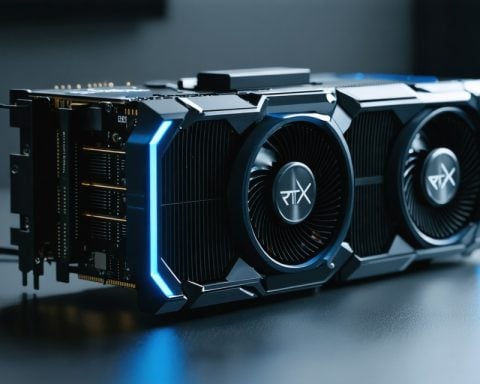Nvidia’s recent ascension to become the world’s most valuable company is a testament to its dominance in the field of artificial intelligence (AI) chips. While the company was relatively unknown a few years ago, it has now surpassed tech giants like Apple and Microsoft in market capitalization. This remarkable rise can be attributed to the rapid advancements in generative AI, where Nvidia plays a crucial role as a leading manufacturer of specialized chips.
In today’s world, technology companies are at the forefront of the global economy, with AI and related technologies expected to shape the future. As a result, there is intense competition among tech giants and startups to gain a competitive edge in this field. Governments are also keen to adopt AI, attracting significant investment from speculative finance capital.
So why is Nvidia leading the charge in AI development? While AI is typically associated with software companies, chipmakers like Nvidia play a pivotal role in providing the necessary computing power for AI technologies. AI models, particularly those built on artificial neural networks, rely heavily on large data sets and require immense computing power. Nvidia’s Graphics Processing Units (GPUs) are uniquely suited for these tasks, outperforming traditional Central Processing Units (CPUs) found in standard computers.
Originally known for manufacturing GPUs for gaming consoles, Nvidia’s breakthrough came when AI researchers realized the massive computing power GPUs could provide for machine learning technologies. As demand for these high-performance computing platforms grew, so did Nvidia’s profits. For example, OpenAI’s GPT-3 language model alone required GPUs worth around $5 million to train effectively.
Nvidia’s success story, however, brings to light some concerns surrounding the AI industry. The rapid growth of AI technologies has led to centralization and monopolization, with large corporations and global finance capital likely to dominate the market. The high costs of acquiring AI computing platforms and the immense energy consumption required also contribute to this centralization. As a result, only companies with significant financial resources can thrive in this industry.
The question arises: will the industry prioritize society’s broader interests as technology continues to transform society? There are concerns about the lack of infrastructure for independent research, with experts being drawn away from universities and into private industry. Calls have been made for increased funding and national infrastructure to support university researchers in conducting AI research on par with private companies.
Additionally, the chip industry itself plays a critical role in technological advancement and globalization. Chips are essential components in various technologies, and their production relies on a complex global supply chain. Nvidia’s rise symbolizes the fierce competition for computing power in an era where advanced technologies determine global economic and political power.
As Nvidia continues to dominate the AI chip market, it remains a central player in the global race for technological superiority. With the potential to shape the future of AI and related technologies, Nvidia’s innovative solutions and powerful chips position it at the forefront of the industry. However, as the race intensifies, it is crucial to ensure that societal interests are protected and that the benefits of technological advancement are accessible to all.
Additional relevant facts about Nvidia:
1. Nvidia’s focus extends beyond AI chips: While Nvidia is known for its AI chips, the company also designs and manufactures graphics processing units (GPUs) for gaming, data centers, and automotive applications. Their GPU technology has been widely adopted in the gaming industry and is used by millions of gamers worldwide.
2. Collaboration with leading tech companies: Nvidia has formed strategic partnerships and collaborations with major tech companies like Amazon, Google, and Microsoft to enhance AI capabilities and accelerate the development of AI applications. These partnerships further solidify Nvidia’s position as a leader in the AI industry.
3. Expansion into autonomous vehicles: Nvidia has made significant investments in autonomous vehicle technology, aiming to become a key player in the emerging self-driving car market. The company’s AI-powered hardware and software solutions enable advanced driver-assistance systems and autonomous driving functions.
Key questions and answers:
1. What sets Nvidia apart from other chipmakers in the AI industry?
Nvidia’s GPUs are well-suited for AI workloads due to their parallel computing architecture, making them more efficient and faster than traditional CPUs. This specialization has given Nvidia a competitive advantage in the AI chip market.
2. What challenges does Nvidia face in the AI industry?
One of the challenges Nvidia faces is the increasing competition from other chipmakers and tech giants who are investing heavily in AI hardware. Maintaining technological leadership and staying ahead of competitors is crucial for Nvidia’s continued success.
3. Is Nvidia’s dominance in the AI chip market sustainable?
While Nvidia currently holds a prominent position in the AI chip market, the industry is evolving rapidly, and new players could emerge with disruptive technologies. Nvidia will need to continue innovating and adapting to maintain its position of leadership.
Advantages and disadvantages:
Advantages:
– Nvidia’s specialized GPUs offer superior performance and efficiency for AI workloads, giving the company a competitive edge in the market.
– Strategic partnerships with tech giants provide access to a vast network of resources and expertise, enhancing Nvidia’s ability to develop cutting-edge AI solutions.
– Expansion into emerging markets like autonomous vehicles diversifies Nvidia’s revenue streams and positions the company for long-term growth.
Disadvantages:
– The high costs associated with AI computing platforms and energy consumption can limit access to Nvidia’s technology, leading to concerns of centralization and monopolization in the market.
– The rapid pace of technological advancement in the industry poses challenges for Nvidia to continuously innovate and adapt to stay ahead of competitors.
– There are calls for more support and funding for independent AI research, as the industry has seen a shift of experts from universities to private industry.
Related links:
NVIDIA News
NVIDIA Official Website



















